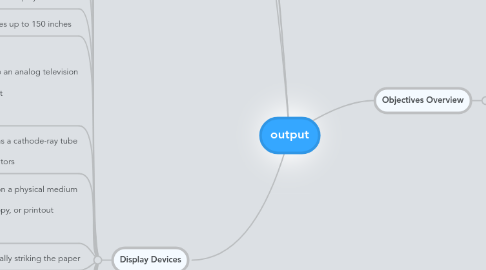
1. What is output
1.1. Outputis data that has been processed into a useful form
1.2. An output deviceis any type of hardware component that conveys information to one or more people
1.2.1. display divices
1.2.2. printer
1.2.3. Speakers, headphones, and earbuds
1.2.4. Data projectors
1.2.5. Interactive whiteboards
1.2.6. Force‐feedback game controllers
1.2.7. Tactile output
2. Display Devices
2.1. A display devicevisually conveys text, graphics, and video information
2.2. A monitoris packaged as a separate peripheral – LCD monitor – Widescreen
2.3. Liquid crystal display (LCD) uses a liquid compound to present information on a display device
2.4. The quality of an LCD monitor or LCD screen depends primarily on: resolution, respon time brightness dot pitch contrast ratio
2.5. Resolutionis the number of horizontal and vertical pixels in a display device – A higher resolution uses a greater number of pixels
2.6. The graphics processing unit (GPU) controls the manipulation and display of graphics on a display device • LCD monitors use a digital signal and should plug into a DVI port, and HDMI port, or a DisplayPort
2.7. Plasma monitorsare display devices that use gas plasma technology and offer screen sizes up to 150 inches
2.8. • Televisions also are a good output device • Require a converter if you are connecting your computer to an analog television • Digital television (DTV) offers a crisper, higher‐quality output HDTVis the most advanced form of digital television
2.9. A CRT monitoris a desktop monitor that contains a cathode‐ray tube – Have a much larger footprint than do LCD monitors
2.10. A printerproduces text and graphics on a physical medium – Printed information is called a hard copy, or printout – Landscape or portrait orientation
2.11. A nonimpact printerforms characters and graphics on a piece of paper without actually striking the paper
2.12. An ink‐jet printerforms characters and graphics by spraying tiny drops of liquid ink onto a piece of paper – Color or black‐and‐white – Printers with a higher dpi (dots per inch) produce a higher quality output
2.13. A photo printerproduces color photo‐lab‐quality pictures
2.13.1. pictures•Most use ink‐jet technology•PictBridge allows you to print photos directly from a digital camera•Print from a memory card and preview photos on a built‐in LCD screen
2.14. A multifunction peripheral(MFP) is a single device that prints, scans, copies, and in some cases, faxes – Sometimes called an all‐in‐one device
2.15. A thermal printergenerates images by pushing electrically heated pins against the heat‐sensitive paper
2.15.1. Thermal wax‐transfer
2.15.2. sublimation printer
2.16. A mobile printeris a small, lightweight, battery‐powered printer that allows a mobile user to print from a mobile device
2.17. • A label printeris a small printer that prints on adhesive‐type material • A postage printer prints postage stamps – Postage also can be printed on other types of printe
2.18. • Plottersare used to produce high‐quality drawings • Large‐format printerscreate photo‐realistic quality color prints on a larger scale
2.19. Speakers, Headphones, and Earbuds
2.19.1. An audio output deviceproduces music, speech, or other sounds
2.19.1.1. Most computer users attach speakersto their computers to:•Generate higher‐quality sounds for playing games•Interact with multimedia presentations•Listen to music•View movies
2.19.2. • Headphonesare speakers that cover your head or are placed outside of the ear • Earbuds(also called earphones) rest inside the ear canal
2.19.3. • Some speakers are specifically designed to play audio from a portable media player – Wireless speakers
2.19.4. Voice outputoccurs when you hear a person’s voice or when the computer talks to you through the speakers•Some Web sites dedicate themselves to providing voice output•Often works with voice input•VoIP uses voice output and voice input
3. Other Output Devices
3.1. Other output devices are available for specific uses and applications
3.1.1. Data projectorsInteractive whiteboardsForce‐feedback game controllersTactile output
